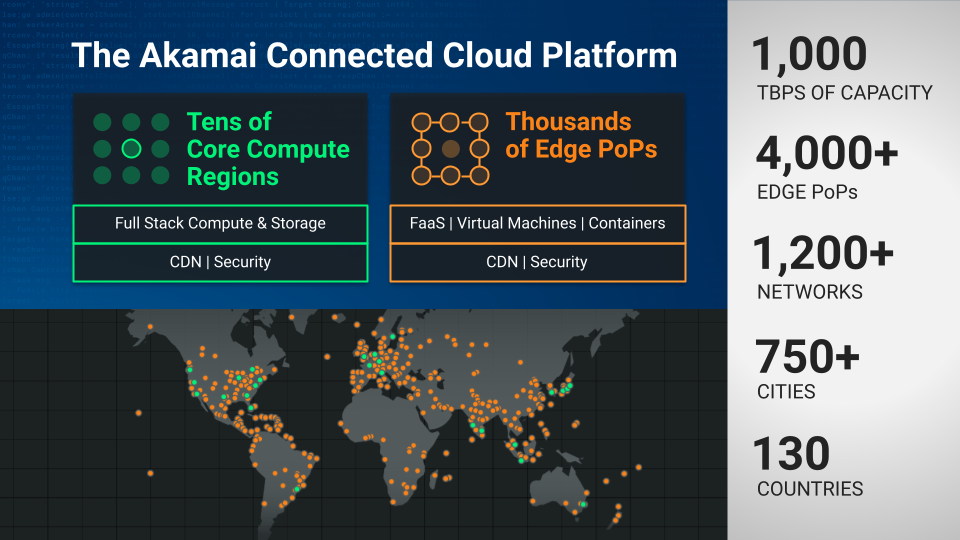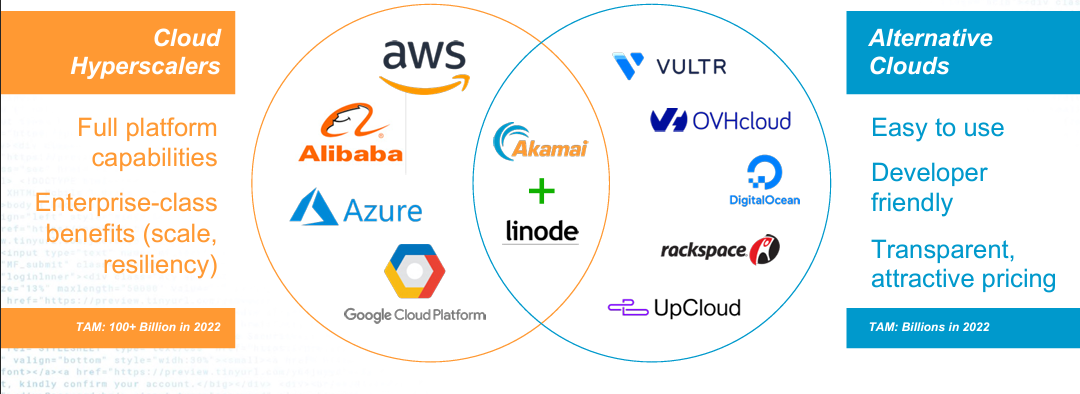Akamai Technologies wants to be your infrastructure as a service alternative by offering compute at the edge of networks for low-latency workloads. Akamai, which acquired cloud services provider Linode in 2022, has just completed its third wave of new compute regions.
The company added locations in Latin America as well as Europe and now has cloud centers around the world. Akamai has core compute regions around the U.S., London, Frankfurt, Singapore, Sydney, Tokyo as well as Sao Paulo. Akamai's cloud infrastructure is designed to reach hard-to-access markets by connecting compute to the 4,100 edge points of presence in 131 countries.
Akamai is best known for its content delivery network, but also has a large security business. In its latest quarter, Akamai's cloud business hit an annual revenue run rate approaching $500 million. Security and content delivery each have an annual revenue run rate of about $1.6 billion or so.
Tom Leighton, CEO of Akamai, said on the company's second quarter earnings conference call that there's room for another cloud provider focused on edge applications and optimization. "A common theme that I heard when I met with executives from around the world in Q2 was their growing concern about being locked into contracts with cloud giants that are consuming large and rapidly increasing shares of their IT budgets," he said. "They want more choice in compute."
Why do these CXOs want more cloud choices? Data egress fees. Compute has to go where the data resides or enterprises get crushed with egress fees. For Akamai customers that use the company's security and content delivery services there are no egress fees if you get compute. Akamai offers a set of cloud services including compute, Kubernetes, storage, database (MySQL, PostgreSQL), networking and developer tools
Media companies are a likely target for Akamai's cloud infrastructure since their cloud providers (notably Amazon and Google) are also competitors. Given that backdrop I caught up with Akamai CTO Robert Blumofe to talk shop. Here's the recap and key points of our chat.
The vision. Blumofe said Akamai is progressing with the vision laid out in 2022. One part of the vision is to grow Akamai's cloud compute capacity and by the end of 2023, it will have 26 new locations. The second part of the vision was to create an enterprise level offering. "Linode focused on developers with its primary offering. It had the core technology, but there was a gap with what enterprise customers expected," explained Blumofe. "We are working to close those gaps."

Blumofe added that Akamai is adding compliance, ID management, virtual private cloud and other features for enterprises. "The third part of the vision is building out a distributed cloud infrastructure where you can run arbitrary compute functions in a large number of locations near the edge," said Blumofe. "It's the next generation of edge computing and a longer development process that's proceeding well. You'll hear announcements in 2024."
- Constellation ShortList™ Global IaaS for Next-Gen Applications
- Constellation ShortList™ Digital Performance Management
Timing. Blumofe noted that Akamai has always been involved with edge computing in some form, but the timing is right for a distributed cloud architecture. "The time is right now," said Blumofe. "Applications are architected for micro services and have components in different places with a container model. The world is ready for edge computing to come into its own."
Use cases. Typically, edge use cases will be dominated by CPUs where GPUs will be training models at the core. "For edge inference the computation load is small and done nicely on CPUs," he said. Media companies will have multiple use cases since they need low latency interactions with customers for entertainment and games. "So many enterprises are seeing cloud costs spin out of control due to egress," said Blumofe, who added that B2C companies with distributed users will look to distributed cloud services. E-commerce and financial services will also find use cases.
Overall, the use cases for the distributed cloud will revolve around applications where computation needs to be near the data from users, devices and things. "Compute is location sensitive and developers and will be able to put computation where it should be," said Blumofe. "We're moving compute to data rather than data to compute."
Another flavor of IaaS. Blumofe said Akamai's cloud computing business isn't designed to compete with hyperscalers and isn't focusing on a niche either. It fits in the middle. "I'd classify us as another flavor of IaaS. With hyperscalers you get locked into a platform where there are costs, vulnerabilities and single points of failure," explained Blumofe. "As multicloud approaches evolve enterprises will reduce platform lock0in and focus on infrastructure. There's a lot you can do without being locked in. We focus on infrastructure that does simple things very well with containers, autoscaling and load balancing."

The evolution of multicloud. Blumofe said many companies are using multiple clouds due to acquisitions and independent divisions, but that doesn't classify as multicloud. "You are truly multicloud when you use multiple clouds for any given application," he said. "That's where people want to go--using multicloud to run any given application on any cloud."
What's driving sales? Blumofe said Akamai is adding locations because two big drivers for the business are data sovereignty requirements and egress charges. Customers are also looking for more options, a simple cost model and low latency. "The structure of the Internet has become more distributed. It happened with content delivery and then security. It'll happen to compute too," said Blumofe.


